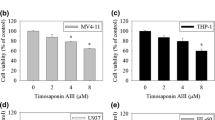Abstract
Objectiv
To investigate the effects of Tounongsan (透脓散) extract (TNSE) on proliferation and e: apoptosis of the human lymphoma cell line Raji and its possible mechanism of action.
Methods
The viability of: TNSE-treated Raji cells was measured by a 3-(4,5-dimethyl-thiazol-2-yl)-2,5-diphenyltetrazolium bromide assay. Cell apoptosis was determined by flow cytometry. The molecular mechanisms of TNSE-mediated apoptosis were further investigated by reverse transcription-polymerase chain reaction (RT-PCR) analysis of the mRNA expression of nuclear factor κB (NF-κB), Bcl-xL, Bcl-2-associated death promoter (Bad), caspase-9 and caspase-3. Western blotting was used to detect the protein expressions of NF-κB, Bad, cleaved caspase-9 and cleaved caspase-3.
Results
TNSE inhibited Raji cell proliferation in dose- and time-dependent manners.: After 48-h treatment with various concentrations of TNSE (125, 250 and 500 μg/mL), the apoptosis rates of Raji cell were 12.23%±1.98% (P<0.05), 20.97%±3.96% (P<0.01) and 30.4%±4.87% ( P<0.01), respectively, compared with those of the control (6.02%±1.01%). RT-PCR demonstrated that NF-κB mRNA expression was significantly downregulated in Raji cells treated with 250 μg/mL TNSE for 48 h (P<0.05), while Bad, caspase-9 and caspase-3 mRNA levels were upregulated (P<0.05). Moreover, TNSE treatment resulted in downregulation of NF-κB protein expression and strikingly upregulated protein expressions of Bad, cleaved caspase-9, cleaved caspase-3 in a dose-dependent manner, as determined by Western blot.
Conclusion
TNSE exhibits significant: anti-proliferative and apoptotic effects in Raji cells, which may be involved in regulation of NF-κB and Bad, and activation of caspase-9 and caspase-3.
Similar content being viewed by others
References
Jemal A, Siegel R, Ward E, Hao Y, Xu J, Murray T, et al. Cancer Statistics, 2008. CA Cancer J Clin 2008;58:71–96.
Chiu J, Yau T, Epstein RJ. Complications of traditional Chinese/herbal medicines (TCM)—a guide for perplexed oncologists and other cancer caregivers. Support Care Cancer 2009;17:231–240.
Liu A, Chen H, Wei W, Ye S, Liao W, Gong J, et al. Antiproliferative and antimetastatic effects of emodin on human pancreatic cancer. Oncol Rep 2011;26:81–89.
Maimon Y, Karaush V, Yaal-Hahoshen N, Ben-Yosef R, Ron I, Vexler A, et al. Effect of Chinese herbal therapy on breast cancer adenocarcinoma cell lines. J Int Med Res 2010;38:2033–2039.
Nakamura T, Seto M, Tajika M, Kawai H, Yokoi T, Yatabe Y, et al. Clinical features and prognosis of gastric MALT lymphoma with special reference to responsiveness to H. pylori eradication and API2-MALT1 status. Am J Gastroenterol 2008;103:62–70.
Kenney S, Theodore E. Woodward Award: development of novel, EBV-targeted therapies for EBV-positive tumors. Trans Am Clin Climatol Assoc 2006;117:55–73.
Kurokawa M, Hiramatsu N, Oze T, Yakushijin T, Miyazaki M, Hosui A, et al. Long-term effect of lamivudine treatment on the incidence of hepatocellular carcinoma in patients with hepatitis B virus infection. J Gastroenterol 2012 Jan 11. [Epub ahead of print]
Rittenhouse JR, Lui PD, Lau BH. Chinese medicinal herbs reverse macrophage suppression induced by urological tumors. J Urol 1991;146:486–490.
Tin MM, Cho CH, Chan K, James AE, Ko JK. Astragalus saponins induce growth inhibition and apoptosis in human colon cancer cells and tumor xenograft. Carcinogenesis 2007;28:1347–1355.
Fu YS, Lin YY, Chou SC, Tsai TH, Kao LS, Hsu SY, et al. Tetramethylpyra-zine inhibits activities of glioma cells and glutamate neuro-excito-toxicity: potential therapeutic application for treatment of gliomas. Neuro Oncol 2008;10:139–152.
Kan WL, Cho CH, Rudd JA, Lin G. Study of the anti-proliferative effects and synergy of phthalides from Angelica sinensis on colon cancer cells. J Ethnopharmacol 2008;120:36–43.
Xu Z, Zhao XD, Wang YM, Xu Z, Chen XH, Bi KS. Identification and anti-tumor activity determination about anti-tumor components of Gleditsia sinensis Lam Stings. J Shenyang Pharma Univ (Chin) 2008;25:108–111.
Linsalata M, Orlando A, Messa C, Refolo MG, Russo F. Quercetin inhibits human DLD-1 colon cancer cell growth and polyamine biosynthesis. Anticancer Res 2010;30:3501–3507.
Hanahan D, Weinberg RA. The hallmarks of cancer. Cell 2000;100:57–70.
Tamatani T, Azuma M, Motegi K, Takamaru N, Kawashima Y, Bando T. Cepharanthin-enhanced radiosensitivity through the inhibition of radiation-induced nuclear factor-kappaB activity in human oral squamous cell carcinoma cells. Int J Oncol 2007;31:761–768.
Li Q, Verma IM. NF-kappaB regulation in the immune system. Nat Rev Immunol 2002;2:725–734.
Jost PJ, Ruland J. Aberrant NF-κB signaling in lymphoma: mechanisms, consequences, and therapeutic implications. Blood 2007;109:2700–2707.
Espinosa I, Briones J, Bordes R, Brunet S, Martino R, Sureda A, et al. Activation of the NF-kappaB signalling pathway in diffuse large B-cell lymphoma: clinical implications. Histopathology 2008;53:441–449.
Heckman CA, Cao T, Somsouk L, Duan H, Mehew JW, Zhang CY, et al. Critical elements of the immunoglobulin heavy chain gene enhancers for deregulated expression of bcl-2. Cancer Res 2003;63:6666–6673.
Zhou H, Du MQ, Dixit VM. Constitutive NF-kappaB activation by the t(11;18)(q21;q21) product in MALT lymphoma is linked to deregulated ubiquitin ligase activity. Cancer Cell 2005;7:425–431.
Zhang H, Yan D, Shi X, Liang H, Pang Y, Qin N, et al. Transmembrane TNF-alpha mediates “forward” and “reverse” signaling, inducing cell death or survival via the NF-kappaB pathway in Raji Burkitt lymphoma cells. J Leukoc Biol 2008;84:789–797.
Pham LV, Tamayo AT, Yoshimura LC, Lo P, Ford RJ. Inhibition of constitutive NF-kappa B activation in mantle cell lymphoma B cells leads to induction of cell cycle arrest and apoptosis. J Immunol 2003;171:88–95.
Fu L, Lin-Lee YC, Pham LV, Tamayo A, Yoshimura L, Ford RJ. Constitutive NF-kappaB and NFAT activation leads to stimulation of the BLyS survival pathway in aggressive B-cell lymphomas. Blood 2006;107:4540–4548.
Keutgens A, Robert I, Viatour P, Chariot A. Deregulated NF-kappaB activity in haematological malignancies. Biochem Pharmacol 2006;72:1069–1080.
Prashant Bavi, Shahab Uddin, Rong Bu, Maqbool Ahmed, Jehad Abubaker, Valorie Balde, et al. The biological and clinical impact of inhibition of NF-κB-initiated apoptosis in diffuse large B cell lymphoma (DLBCL). J Pathol 2011;224:355–366.
Jeong SY, Seol DW. The role of mitochondria in apoptosis. BMB Rep 2008;41:11–22.
Thees S, Hubbard GB, Winckler J, Schultz C, Rami A. Specific alteration of the Bax/Bcl2 ratio and cytochrome c without execution of apoptosis in the hippocampus of aged baboons. Restor Neurol Neurosci 2005;23:1–9.
Martinou JC, Green DR. Breaking the mitochondrial barrier. Nat Rev Mol Cell Biol 2001;2:63–67.
Lazebnik YA, Kaufmann SH, Desnoyers S, Poirier GG, Earnshaw WC. Cleavage of poly (ADP-ribose) polymerase by a proteinase with properties like ICE. Nature 1994;371:346–347.
Juin P, Geneste O, Raimbaud E, Hickman JA. Shooting at survivors: Bcl-2 family members as drug targets for cancer. Biochim Biophys Acta 2004;1644:251–260.
Reed JC, Pellecchia M. Apoptosis-based therapies for hematologic malignancies. Blood 2005;106:408–418.
Zimmermann KC, Bonzon C, Green DR.The machinery of programmed cell death. Pharmacol Ther 2001;92:57–70.
Ranger AM, Zha J, Harada H, Datta SR, Danial NN, Gilmore AP, et al. Bad-deficient mice develop diffuse large B cell lymphoma. Proc Natl Acad Sci USA 2003;100:9324–9329.
Wang JL, Liu D, Zhang ZJ, Shan S, Han X, Srinivasula SM, et al. Structure-based discovery of an organic compound that binds Bcl-2 protein and induces apoptosis of tumor cells. Proc Natl Acad Sci USA 2000;97:7124–7129.
Author information
Authors and Affiliations
Corresponding author
Additional information
Supported by A Project of the Priority Academic Program Development of Jiangsu Higher Education Institutions (No. 012062003010), Project of Top Talented Personnel in Six Profession In Jiangsu Province (No. 2011-WS-049) and Project of Jiangsu Province Hospital of Traditional Chinese Medicine (No. 2010-Y1008).
Rights and permissions
About this article
Cite this article
Fang, Lh., Wang, Rp., Hu, Sy. et al. Tounongsan (透脓散) extract induces apoptosis in cultured Raji cells. Chin. J. Integr. Med. 18, 522–528 (2012). https://doi.org/10.1007/s11655-012-1145-4
Received:
Published:
Issue Date:
DOI: https://doi.org/10.1007/s11655-012-1145-4




